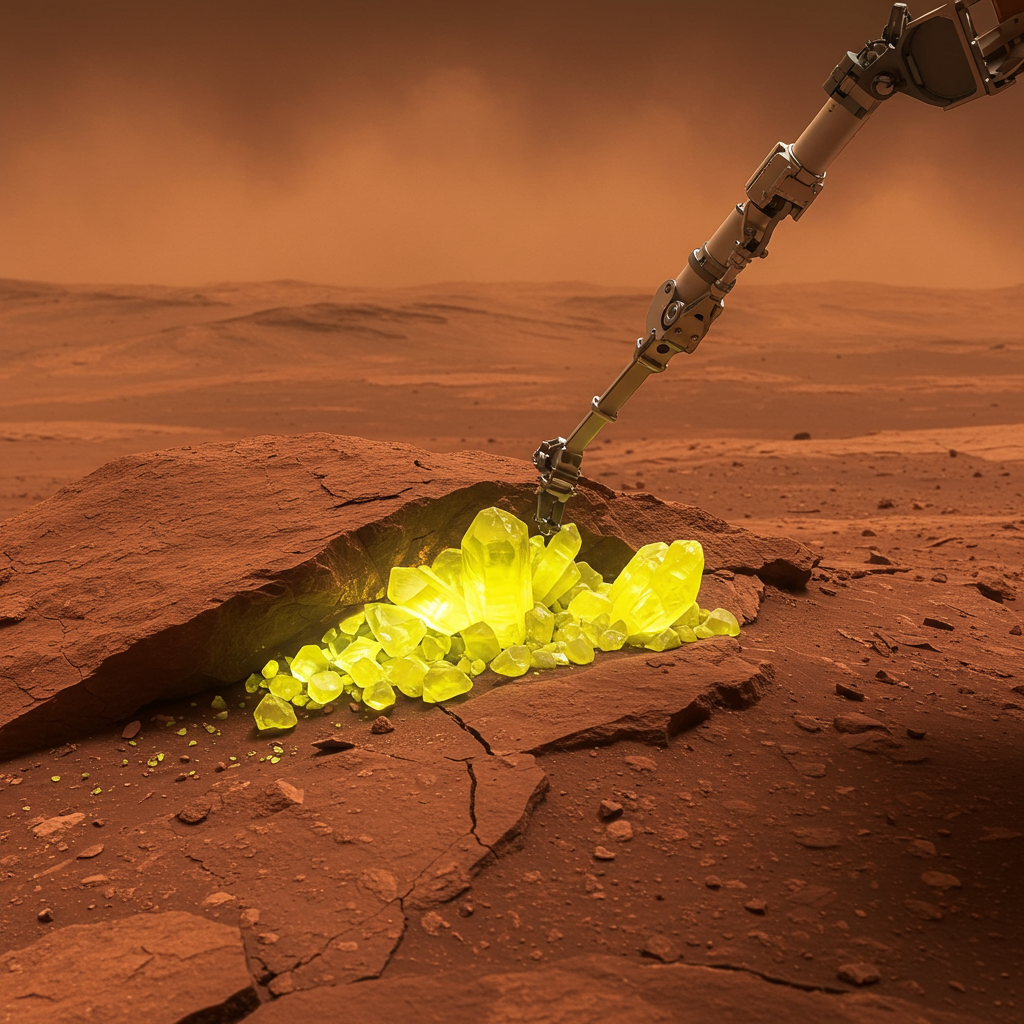NASA’s Curiosity rover, diligently exploring the Martian landscape, has stumbled upon a truly surprising find that is rewriting our understanding of the Red Planet’s complex geological past. While traversing the challenging terrain of Mount Sharp’s Gediz Vallis channel, the rover inadvertently cracked open a seemingly unremarkable rock, revealing bright yellow crystals hidden within. This unexpected discovery marks the first time pure, elemental sulfur – often historically referred to as “brimstone” – has been identified on the surface of Mars.
The find is particularly significant because, while sulfur compounds (sulfates) are known to exist widely on Mars, this represents the pure elemental form. It suggests geological processes occurred in this specific region that scientists previously didn’t believe were present, offering compelling new clues about the planet’s history and potentially its capacity for past habitability.
An Accidental Martian Revelation
The groundbreaking discovery wasn’t the result of a targeted search for elemental sulfur, but rather a fortunate accident of exploration. In May 2023, the 899-kilogram (1,982-pound) Curiosity rover was navigating the boulder-strewn floor of the Gediz Vallis channel. As its robust wheels rolled over a brittle piece of rock, the pressure caused the mineral lump to break apart.
The fractured rock exposed a patch of striking yellow material inside. Recognizing the unusual appearance, the mission team quickly directed the rover’s instruments to analyze the revealed crystals. Curiosity’s onboard scientific tools confirmed their composition: pure elemental sulfur. This raw form of sulfur is chemically distinct from sulfates, which are salts where sulfur is combined with oxygen and other elements.
Pure Sulfur vs. Martian Sulfates
For years, rovers like Curiosity and Opportunity have detected abundant sulfates across vast regions of Mars. These sulfate minerals, such as gypsum or kieserite, typically form when sulfur-rich compounds mix with other minerals in water. As the water evaporates, it leaves behind concentrated salt deposits. The presence of sulfates has been a key indicator of Mars’s ancient water history, telling scientists about past lakes, seas, and groundwater activity.
Elemental sulfur, however, tells a different story. It forms under a much narrower set of specific conditions, often involving volcanic activity, hydrothermal vents, or interactions with certain types of bacteria in low-oxygen environments. Finding pure sulfur crystals, especially in a location already rich in sulfates, presents a geological puzzle. It suggests localized conditions existed that allowed elemental sulfur to form or accumulate, potentially alongside or after the processes that created the surrounding sulfate deposits.
Why This Discovery Matters
The detection of elemental sulfur on Mars for the first time is far more than just a chemical identification; it opens up new avenues of scientific inquiry into the Red Planet’s past environments.
Clues About Martian Geology
The unexpected presence of pure sulfur directly challenges previous assumptions about the geological history of the Gediz Vallis channel area. Scientists believed they understood the general processes that shaped this region – primarily water flow and landslide deposits creating a jumbled mix of rocks. The presence of elemental sulfur points to a different or additional set of geological activities.
Curiosity project scientist Ashwin Vasavada noted the surprising nature of the find, stating in July 2024 that discovering what appears to be a field of pure sulfur stones is “like finding an oasis in the desert.” He explained that such deposits “shouldn’t be there, so now we have to explain it.” This unexpectedness underscores the excitement of planetary exploration, where discoveries often raise new questions and push the boundaries of our understanding. Following the accidental crack, scientists identified other rocks in the vicinity that visually resemble the sulfur-bearing rock before it was broken, suggesting elemental sulfur might be more widespread in localized patches within the channel than previously thought.
Implications for Past Life
While finding elemental sulfur doesn’t confirm the existence of life on Mars, it adds another crucial piece to the puzzle of the planet’s potential past habitability. Sulfur is an essential element for all known life forms. Organisms typically incorporate sulfur through sulfates to build vital components like amino acids (two of which are sulfur-containing) needed for proteins.
However, certain types of microbes on Earth can also utilize elemental sulfur or other sulfur compounds directly as an energy source, particularly in environments lacking oxygen, such as deep-sea hydrothermal vents or volcanic areas. The discovery of elemental sulfur could indicate environmental conditions – perhaps linked to past hydrothermal activity or unique chemical interactions – that might have provided energy sources or suitable niches for ancient microbial life, if it ever existed on Mars. It strengthens the case that Mars possessed many of the fundamental chemical building blocks and energy gradients that life could potentially exploit.
Exploring Gediz Vallis
The location of the discovery, the Gediz Vallis channel, is a key target for Curiosity’s exploration on the flanks of Mount Sharp. This prominent gash running down the mountain is believed to be an ancient channel carved by vigorous flows of water and debris billions of years ago. Studying the rocks and deposits within Gediz Vallis allows scientists to piece together the environmental story of Mars, particularly the periods when liquid water was shaping the landscape.
Evidence within the channel suggests a dynamic past, including energetic floods that transported rounded rocks and boulder-rich flows resulting from landslides. Signs of water-rock interaction, such as bleached “halo” features resembling those formed by groundwater on Earth, are also present. This complex history makes the channel a prime location to search for minerals deposited by water and potentially preserved signs of past habitable conditions.
The Next Steps
With the surprising find confirmed, the immediate next step for scientists is to understand how elemental sulfur came to be concentrated in this specific region of Mars. This will require detailed analysis of the chemical and mineralogical context surrounding the sulfur deposits.
Although the brittle sulfur rocks themselves were too small and fragile for Curiosity’s main drill, the rover team successfully collected a sample from a larger, sturdier rock nearby, nicknamed “Mammoth Lakes,” on June 18. Analysis of this drilled sample by Curiosity’s internal instruments may reveal associated minerals or chemical signatures that shed light on the formation mechanisms of the elemental sulfur. Was it linked to ancient volcanism, hydrothermal processes, or a unique form of water-rock chemistry? Answering these questions will involve complex geological modeling and further data collection as Curiosity continues its slow climb and exploration of Mount Sharp, always on the lookout for the next unexpected revelation about the Red Planet.
Frequently Asked Questions
What Type of Sulfur Did Curiosity Find on Mars?
The Curiosity rover discovered pure, elemental sulfur crystals inside a Martian rock. This is the first time elemental sulfur, sometimes called “brimstone,” has been found on Mars. It is distinct from sulfates, which are sulfur-based minerals mixed with other elements, and which are relatively common on the Red Planet.
Where Did Curiosity Discover Pure Sulfur on Mars?
Curiosity found the elemental sulfur within a rock in the Gediz Vallis channel, located on the flank of Mount Sharp inside Gale Crater. This area is significant because it’s believed to be an ancient waterway or debris flow channel, preserving a record of Mars’s past wet environmental conditions.
Why Is Elemental Sulfur Finding on Mars Significant?
Finding elemental sulfur is significant for several reasons. Firstly, it was unexpected in this location, suggesting geological processes occurred that scientists didn’t previously know about, such as potential past volcanic or hydrothermal activity. Secondly, sulfur is essential for life, and while finding elemental sulfur alone doesn’t confirm life, it adds to the growing evidence of chemical ingredients and potential energy sources that could have supported microbial life on ancient Mars.




